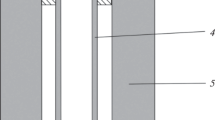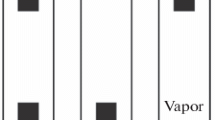Abstract
Experiments were carried out in hermetically sealed platinum capsules, with water saturated with silica with respect to quartz at 300°C in the lower parts of the electric furnaces, where the temperature slightly increases upward at 0.15°C/cm. Our earlier studies (Alekseyev and Medvedeva, 2017) have shown that these exactly experimental parameters are favorable for silica transfer from the liquid to vapor phase. The statistically processed experimental results show that the molal silica concentration in the liquid phase (m) exponentially decreases with time. This dependence and the fact that the newly produced opal occurs on the capsule walls above the meniscus are consistent with the distillation model. The scatter of the experimental m values turned out to be caused not by differences in the temperature gradient in different wells of the electric furnaces but by the natural roughness of the inner walls of the capsules, which differed from one capsule to another and could even change with time in any given capsule. In the capsules with roughness artificially made on their walls, m decreased much more rapidly, and not only in the bottom but also in the upper parts of the electric furnaces, where temperature decreased upward (–0.08°C/cm). This may suggest that the discovered phenomenon is spread in nature more widely than surmised previously, because this phenomenon does not strongly depend on the direction of the temperature gradient, and voids in natural rocks usually have rough walls.
Similar content being viewed by others
References
A. W. Adamson and A. P. Gast, Physical Chemistry of Surfaces. 6th ed., (John Wiley & Sons, New York, 1997).
V. A. Alekseyev and L. S. Medvedeva, “Silica distribution in the system quartz–water–vapor depending on the temperature gradient,” Geochem. Int. 56 (2), 136–147 (2018).
V. A. Alekseyev, V. M. Balashov, and G. P. Zaraisky, “Kinetics and modeling of fluid–rock interactions,” Petrology 5, 37–44 (1997).
V. A. Alekseyev, L. S. Medvedeva, L. N. Kochnova, and O. A. Tytyunnik, “Mechanisms of silica precipitation from hydrothermal solutions: The effects of solution evaporations and quartz seed crystals,” Geochem. Int. 48 (2) 178–182 (2010).
V. A. Alexeyev, L. S. Medvedeva, and N. P. Starshinova, “Paradoxical transformation of the equilibrium quartz–water system into an unequilibrated one,” Geochem. Int. 51(5), 382–404 (2013).
J. Bico, C. Tordeux, and D. Quéré, “Rough wetting,” Europhys. Lett. 55, 214–220 (2001).
J. Bico, U. Thiele, and D. Quéré, “Wetting of textured surfaces,” Colloids and Surfaces A 206, 41–46 (2002).
C. Buffone and K. Sefiane, “IR measurements of interfacial temperature during phase change in a confined environment,” Experimental Thermal and Fluid Science 29, 65–74 (2004).
C. Buffone, K. Sefiane, and C. Minetti, “The effect of wall thickness and material on Marangoni driven convection in capillaries,” Colloids and Surfaces A 481, 384–392 (2015).
J. S. Cline, R. J. Bodnar, and J. D. Rimstidt, “Numerical simulation of fluid flow and silica transport and deposition in boiling hydrothermal solutions: application to epithermal gold deposits,” J. Geophys. Res. 97, 9085–9103 (1992).
D. A. Crerar and G. M. Anderson, “Solubility and solvation reactions of quartz in dilute hydrothermal solutions,” Chem. Geol. 8, 107–122 (1971).
J. D. Dana, E. S. Dana, and C. Frondel, The System of Mineralogy. V. 3. Silica Minerals. (John Wiley and Sons, New York, 1962).
P. J. Darragh, A. J. Gaskin, B. C. Terrell, and J. V. Sanders, “Origin of precious opal,” Nature 209 (5018), 13–16 (1966).
D. J. DeMaster, “The diagenesis of biogenic silica: chemical transformations occurring in the water column, seabed, and crust,” in Treatise on Geochemistry V. 7, Ed. by. H. D. Holland and K. K. Turekian, (Elsevier, 2003), pp. 87–98.
P. M. Dove, “Kinetic and thermodynamic controls on silica reactivity in weathering environments,” Rev. Mineral. 31, 235–290 (1995).
L. R. Drees, L. P. Wilding, N. E. Smeck, and A. L. Senkayi, “Silica in soils: Quartz and disordered silica polymorphs,” in Minerals in Soil Environments, Ed. by J. B. Dixon and S. B. Weed, (Soil Sci. Soc. Am., Madison, 1989), pp. 913–974.
S. E. Drummond and H. Ohmoto, “Chemical evolution and mineral deposition in boiling hydrothermal systems,” Econ. Geol. 80, 126–147 (1985).
O. W. Flörke, H. Graetsch, B. Martin, K. Röller, and R. Wirth, “Nomenclature of micro– and non–crystalline silica minerals, based on structure and microstructure,” Neues Jahrbuch Miner. Abh. 163, 19–42 (1991).
R. O. Fournier, and R. W. Potter, “An equation correlating the solubility of quartz in water from 25° to 900°C at pressures up to 10000 bars,” Geochim. Cosmochim. Acta 46, 1969–1973 (1982).
R. M. Gel’man, and I. Z. Starobina, Photometric Methods of Determination of Rock–Forming Elements in Ores, Rocks, and Minerals (Min. Geologii RSFSR, Leningrad, 1970) [in Russian].
I. Gunnarsson and S. Arnórsson, “Amorphous silica solubility and the thermodynamic properties of H4SiO°4 in the range of 0° to 350°C at Psat,” Geochim. Cosmochim. Acta 64, 2295–2307 (2000).
K. M. Hay and M. I. Dragila, “Physics of fluid spreading on rough surfaces.,” Int. J. Numerical Analysis 5, 85–92 (2008).
K. M. Hay, M. I. Dragila, and J. Liburdy, “Theoretical model for the wetting of a rough surface,” J. Colloids Interface Sci. 325, 472–477 (2008).
J. J. Hemley, J. W. Montoya, J. W. Marinenko, and R. W. Luce, “Equilibria in the system Al2O3–SiO2–H2O and some general implications for alteration/mineralization processes,” Econ. Geol. 75, 210–228 (1980).
N. R. Herdianita, P. R. L. Browne, K. A. Rodgers, and K. A. Campbell, “Mineralogical and textural changes accompanying ageing of silica sinter,” Mineral. Deposita 35, 48–62 (2000).
M. Hosaka and S. Taki, “Hydrothermal growth of quartz crystals at low fillings in NaCl and KCl solutions,” J. Cryst. Growth 78, 413–417 (1986).
K. Hoshino, T. Itami, R. Shiokawa, and M. Watanabe, “A possible role of boiling in ore deposition: A numerical approach,” Resource Geol. 56, 49–54 (2006).
M. Hovland, H. G. Rueslåtten, H. K. Johnsen, B. Kvamme, and T. Kuznetsova, “Salt formation associated with sub–surface boiling and supercritical water,” Marine Petrol. Geol. 23, 855–869 (2006).
R. K. Iler, “Formation of precious opal,” Nature 207 (4996). 472–473 (1965).
G. C. Kennedy, “A portion of the system silica–water,” Econ. Geol. 45, 629–653 (1950).
I. N. Kigai and B. R. Tagirov, “Evolution of acidity of hydrothermal fluids related to hydrolysis of chlorides,” Petrology 18, 252–262 (2010).
S. Kitahara, “The solubility of quartz in water at high temperatures and high pressures,” Rev. Phys. Chem. Jpn. 30, 109–114 (1960).
D. London and G. B. Morgan VI,“The pegmatite puzzle,” Elements 8, 263–268 (2012).
E. Merino and Y. Wang, “Self–organization in rocks: occurrences, observations, modeling, testing––with emphasis on agate genesis,” in Non–Equilibrium Processes and Dissipative Structures in Geoscience V. 11, Ed. by H.–J. Krug and J. H. Kruhl, Yearbook “Self–Organization” (Duncker & Humblot, Berlin, 2001), pp. 13–45.
P. Ortoleva, J. Chadam, E. Merino, and A. Sen, “Geochemical self–organization II; the reactive–infiltration instability,” Am. J. Sci. 287, 1008–1040 (1987).
S. S. Panchamgam, A. Chatterjee, J. L. Plawsky, and P. C. Wayner, Jr., “Comprehensive experimental and theoretical study of fluid flow and heat transfer in a microscopic evaporating meniscus in a miniature heat exchanger,” Int. J. Heat Mass Transfer. 51, 5368–5379 (2008).
B. Pewkliang, A. Pring, and J. Brugger, “The formation of precious opal: clues from the opalization of bone,” Can. Mineral. 46, 139–149 (2008).
J. L. Plawsky, M. Ojha, A. Chatterjee, and P. C. Wayner Jr., “Review of the effects of surface topography, surface chemistry, and fluid physics on evaporation at the contact line,” Chem. Engin. Commun. 196, 658–696 (2008).
A. V. Plyasunov, “Thermodynamics of Si(OH)4 in the vapor phase of water: Henry’s and vapor–liquid distribution constants, fugacity and cross virial coefficients,” Geochim. Cosmochim. Acta 77, 215–231 (2012).
R. A. Pollock, G. Yu. Gor, B. R. Walsh, J. Fry, I. T. Ghampson, Yu. B. Melnichenko, H. Kaiser, W. J. DeSisto, M. C. Wheeler, and B. G. Frederick, “Role of liquid vs vapor water in the hydrothermal degradation of SBA–15,” J. Phys. Chem. C 116, 22802–22814 (2012).
D. Quéré, “Rough ideas on wetting,” Physica A 313, 32–46 (2002).
J. D. Rimstidt and H. L. Barnes, “The kinetics of silica–water reactions,” Geochim. Cosmochim. Acta 44, 1683–1699 (1980).
Y. Shibue, “Empirical expressions of quartz solubility in H2O, H2O + CO2, and H2O + NaCl fluids,” Geochem. J. 30, 339–354 (1996).
C. H. Sondergeld and D. L. Turcotte, “A laboratory study of mineral deposition in a boiling environment,” Econ. Geol. 74, 109–115 (1979).
C. I. Steefel and A. C. Lasaga, “A coupled model for transport of multiple chemical species and kinetic precipitation/ dissolution reactions with application to reactive flow in single phase hydrothermal systems,” Am. J. Sci. 294 (5), 529–592 (1994).
M. P. Verma, “Chemical thermodynamics of silica: a critique on its geothermometer,” Geothermics 29, 323–346 (2000).
Y. Wang and E. Merino, “Self–organization origin of agates: Banding, fiber twisting, composition, and dynamic crystallization model,” Geochim. Cosmochim. Acta 54, 1627–1638 (1990).
M. Wangen and I. A. Munz, “Formation of quartz veins by local dissolution and transport of silica,” Chem. Geol. 209, 179–192 (2004).
G. P. Zaraiskii, “The conditions of the nonequilibrium silicification of rocks and quartz vein formation during acidic metasomatism,” Geol. Ore Deposits 41, (4), 262–275 (1999).
Author information
Authors and Affiliations
Corresponding author
Additional information
Original Russian Text © V.A. Alekseyev, L.S. Medvedeva, V.N. Balashov, A.A. Burmistrov, I.N. Gromyak, 2018, published in Geokhimiya, 2018, No. 7.
Rights and permissions
About this article
Cite this article
Alekseyev, V.A., Medvedeva, L.S., Balashov, V.N. et al. Experimental Study of Unequilibrated Silica Transfer from Liquid Water to the Vapor Phase. Geochem. Int. 56, 617–627 (2018). https://doi.org/10.1134/S0016702918070030
Received:
Accepted:
Published:
Issue Date:
DOI: https://doi.org/10.1134/S0016702918070030




